Credit: Don't Want It... Can't Get It...
Massive losses have been seen across all asset classes
(except Treasuries) and time zones (so much for decoupling).
While it is not yet time for broad-based risk-taking, it is
important to weed out any and all financially weak issues.
Investors, in consultation with their financial advisors,
should review their bond and stock positions and the issues
held by mutual funds and managed accounts with an eye toward
identifying those that:
-
Have the capacity to meet their current dividend and
interest payments for the next several years;
-
Do not depend on external financing to meet current
obligations; and
-
Maintain financial integrity based upon balance sheet
fundamentals with only a secondary emphasis on other
issues.
There are certain expectations that we have built into our
forecast. These expectations directly affect our
investment recommendations and posture at this time.
Key assumptions include:
-
That we have moved into a "hard dollar" environment
where those with cash and equity in their investments
will be provided with the most opportunity. Those
who are highly leveraged will confront significant
difficulty.
-
That the coming environment will feature low interest
rates that will encourage risk-taking that could then
prompt recovery and the beginning of the next bull
market.
-
The new administration's campaign agenda will likely be
trumped by the immediacy of the financial and economic
turmoil.
-
More Keynesian-style stimulative packages, coupled with
broadening bailouts for a wide variety of entities over
the next several years. Tax increases are
postponed in this scenario while tax cuts are
accelerated and the Federal budget deficit will likely
rise to over $1 trillion for the 2009 fiscal year.
-
Based on updated inputs to our model, we now expect S&P
500 earnings in the range of $55 (bad case) to $82 (good
case) in after-tax operating earnings. Our best
target estimate for earnings is $62 given our current
outlook for the depth of the recession.
We believe we are witnessing a rare event in our financial
history. This is not the textbook recession where
inventories are the culprit. This is a different
process, and one that will likely take a longer time to
process. The essential difficulty is that
policy-makers have little ability to change the behavior of
actors in the economy who are attempting to save rather than
spend and pare down debts rather than take on more credit.
As economic conditions worsen, and as asset values decline,
it is even more difficult to reverse these trends, which
makes for a vicious cycle. This is why governmental
efforts to stimulate have taken on Herculean proportions and
will likely continue for some time.
The assumption of enormous levels of debt by virtually every
sector of the economy has triggered a period of debt
liquidation. This process began in earnest earlier
this year as Bear Stearns, Lehman Brothers, Fannie Mae,
Freddie Mac, and AIG became essentially insolvent or in
jeopardy of becoming so. The root cause, we believe,
was the unsustainable expansion of debt within the financial
system, which made both borrowers and lenders uncomfortable.
This expansion of borrowing is easily seen here as the sharp
rise in the household debt-to-income ratio that took place
from 2000-2006 (see chart 1).
Chart 1
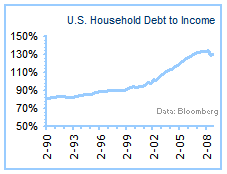
Once joined by falling collateral values in the form of home
prices (see chart 2), both borrowers and lenders pulled back
from the issuance of new debt, which caused a historic
decline in new credit and money creation as evidenced by net
U.S. household borrowing falling from a peak $1.4 trillion
annualized level to under $200 billion (see chart 3).
We believe that household credit demand will not recover
quickly as it has in past cycles because both borrowers and
creditors look to de-lever balance sheets, hoard cash, and
lessen risk. This is due not only to the absolute
levels of debt in the system, but also demographic changes
as the "baby boom" generation moves closer to retirement.
In this environment, we expect savings rates to rise at the
expense of consumption.
Chart 2
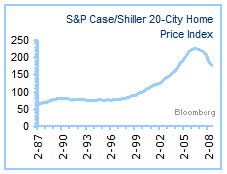
Chart 3
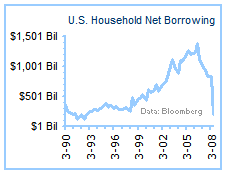
The Federal Reserve was unsuccessful in prompting additional
lending through rate cuts and traditional measures due to
the desire of banks, financial institutions, and homeowners
to pare down debts. Consequently, an array of historic
measures have been taken to force inter-bank lending.
This has resulted in a doubling of the size of the central
bank's balance sheet, from roughly $1 trillion to $2
trillion virtually overnight (see chart 4), as the bank
became the central repository for troubled assets.
While the Federal Reserve would like to see a resumption of
a vibrant level of lending, they cannot force it on a public
that is not interested. In the meantime, the Fed and
the Treasury will continue to try to shore up the inner
workings of the banking system.
If they are unsuccessful, the main risk to the system and to
our outlook is that a cessation of lending makes it
difficult to expand the supply of new money coming into
circulation. As money becomes more scarce, it
increases in value and there can develop a tendency for
households and businesses to hoard cash as it gains in
purchasing power. If such hoarding goes on for an
extended period, it can further retard growth by
discouraging productive investment, and by making the burden
of debtors even greater, since outstanding debts must be
repaid with increasingly valuable currency. This
negative feedback loop is commonly referred to as
"debt-deflation" and would be visible in a general fall in
inflation expectations priced into the bond market along
with a coordinated fall in asset prices (see chart 5, which
shows the forward-implied inflation rate priced into the
market for long-term Treasury Inflation Protected
Securities).
Chart 4
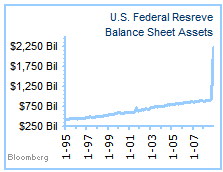
Chart 5
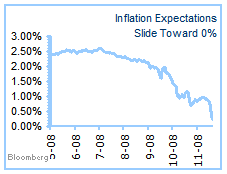
To date, the ongoing liquidation of assets to pay off debts
appears, in many ways, to reflect a debt-deflation rather
than a traditional inventory-driven recession. We have
seen all major asset classes, excluding Treasuries, come
under pressure, and equities have been notably roiled as
evidenced by a historic 68% downward revaluation of the S&P
500 relative to long-term Treasury bonds (see chart 6).
While this is a painful process, this re-pricing is helping
to restore attractive values and yields for risk-takers,
which is an important pre-condition to a bull market.
In time, the re-pricing of risk we have seen in this
bear market will likely help restore balance to financial
markets.
Chart 6
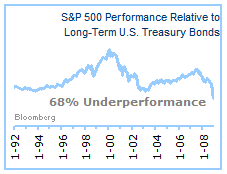
Profitability has come under pressure due to falling demand
and falling prices. Note that net after-tax profits as
a percent of GDP are falling from very elevated levels and
have yet to stabilize (chart 7). To adjust to the
lower expected volume demand, both production (chart 8) and
employment (chart 9) must also be cut. This, in turn,
leads to a lack of confidence (chart 10).
Chart 7
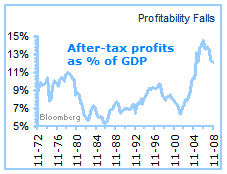
Chart 8
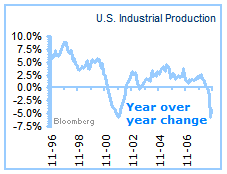
Chart 9
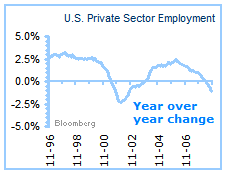
Chart 10
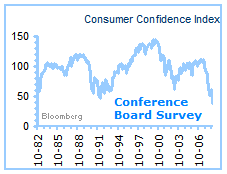
The re-pricing of risk has been a positive start. We
have spoken at length about markets that had been priced as
if risk was a thing of the past. With bond yields at
the short end of the yield curve at nearly 0% and 10-year
Treasury yields near 3.25%, it appears that investors have
reversed course and are now clamoring for the safety of
government bonds and have abandoned riskier assets like
stocks, commodities, real estate, and corporate credits
where default risk seems omnipresent. In time, the
re-setting of risk will be seen as an important
pre-requisite for an eventual recovery in financial markets.
In the here-and-now, however, we remain unconvinced that the
environment is supportive of a sustained bull market --
especially as the de-leveraging process continues.
For now, we continue to watch for improvement, but there is
little substantive fundamental improvement to be found.
One slight bright spot is in the small improvement that can
be seen in our Credit Thermometer, which seeks to measure
the liquidity within the banking system that became frozen
in recent months (chart 11). To learn more about the
indicator, please refer to our September 24
Market Commentary.
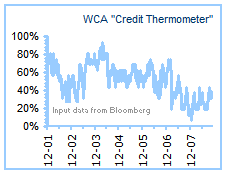
At present, we conclude that credit conditions remain poor
despite some modest improvement in credit conditions in
response to a variety of government-sponsored programs
enacted to stimulate lending at the institutional level (see
chart 10 above).
We will continue to monitor these and other inputs and make
changes accordingly to our recommended tactical asset
allocation exposures in the weeks and months ahead.
We await some sign of improvement in financial market
conditions before committing risk capital. Our current
portfolio emphasizes high grade and liquid assets, including
government bonds and bills.
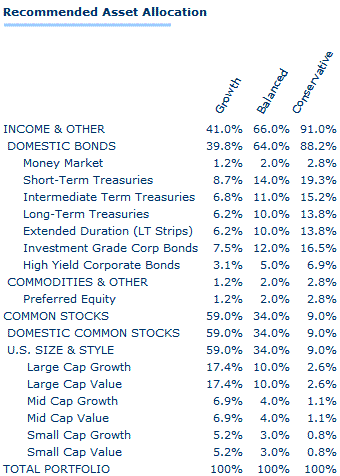
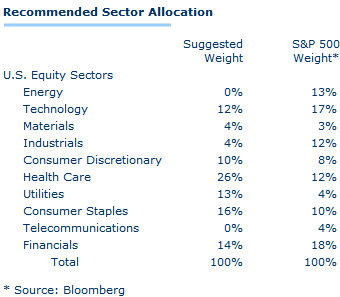 |
Past Commentaries
September 24, 2008
Downgrading Outlook Based on Credit Freeze
More
September 15, 2008
Equity Markets Stumble on Lehman, Merrill, and AIG
More
September 9, 2008
No Change In Strategy On GSE Action
More
July 31, 2008
Quick Take on GDP Report
More
July 21, 2008
Valuation Are Better, But Markets Are Not Out of the
Woods
More
May 20, 2008
Buy the Dips
More
March 10, 2008
Investing During Recession
More
January 22, 2008
Global Sell-off
More
December 27, 2007
Outlook 2008
More
December 7, 2007
NBER President Raises Recession Concerns
More
November 28, 2007
Equity Risk Heightened - Allocation Remains Defensive
More
September 25, 2007
After the Rate Cut
More
July 30, 2007
The Case For Growth
More
June 15, 2007
Data Affirms Tactical Asset Allocation Posture
More
March 19, 2007
Cutting Earnings And Equity Target
More
| |
To unsubscribe, please click here.
Company Name, Address and Contact Details
The information contained herein has been prepared from sources believed to be
reliable but is not guaranteed by us and is not a complete summary or statement
of all available data, nor is it considered an offer to buy or sell any
securities referred to herein. Opinions expressed are subject to change without
notice and do not take into account the particular investment objectives,
financial situation, or needs of individual investors. There is no guarantee
that the figures or opinions forecasted in this report will be realized or
achieved. Employees of Stifel, Nicolaus & Company, Incorporated or its
affiliates may, at times, release written or oral commentary, technical
analysis, or trading strategies that differ from the opinions expressed within.
Past performance is no guarantee of future results. There are special
considerations associated with international investing, including the risk of
currency fluctuations and political and economic events. Investing in emerging
markets may involve greater risk and volatility than investing in more developed
countries. Due to their narrow focus, sector-based investments typically exhibit
greater volatility. Small company stocks are typically more volatile and carry
additional risks, since smaller companies generally are not as well established
as larger companies. Property values can fall due to environmental, economic, or
other reasons, and changes in interest rates can negatively impact the
performance of real estate companies. When investing in bonds, it is important
to note that as interest rates rise, bond prices will fall. High-yield bonds
have greater credit risk than higher quality bonds. The risk of loss in trading
commodities and futures can be substantial. You should therefore carefully
consider whether such trading is suitable for you in light of your financial
condition. The high degree of leverage that is often obtainable in commodity
trading can work against you as well as for you. The use of leverage can lead to
large losses as well as gains. Indices are unmanaged, and you cannot invest
directly in an index.
Stifel, Nicolaus & Company, Incorporated | Member SIPC & NYSE |
www.stifel.com |